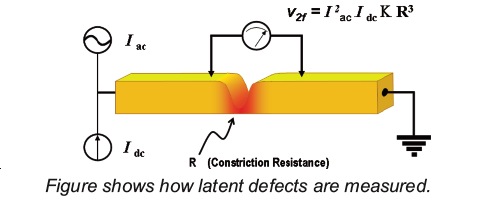Previously Published in August 2009
Our lives in a complex world are increasingly dependent upon ubiquitous electronic devices, many of which are prone to unpredictable failure, leading in some cases to catastrophic losses. A cell phone that dies when inadvertently dropped may be an inconvenience, but a defibrillator failure is a vastly greater concern.
The relevant question is could the failure have been predicted and possibly averted? Difficult, you say, but not impossible. Specifically, can latent defects be found and eliminated before failure?
A compelling case can be put forth that every effort should be made to detect latent defects, particularly for life-critical applications in medical, automotive and aerospace, where one bad connection may cost lives and spawn alarming headline articles in the popular press.
COMMON DEFECTS, MUNDANE CAUSES Although electronic systems are becoming unthinkably complex, commonly occurring latent defects often have rather mundane causes, such as a loose connector, a cracked circuit board, or electroplating along a trail of contamination.
Those who remember the PDP-8 lab computer would understand. When the computer failed, the first thing to try was unplug and plug-in circuit boards in an effort to jar the connectors back to life.
ROLM, a wildly successful company, was founded on the simple premise of offering a Data General Nova computer reworked with mil-spec connectors for added reliability.
Although technology has come a long way, latent defects remain a recurring problem. Moore’s Law has worked its wonders, but the basics of connectors and interconnect technology are littlechanged. Latent defects continue to plague interconnect in all its various forms.
Two heavyweights of interconnect technology, IBM and AMP (now Tyco), wrestled these issues to the ground years ago.1, 2
Test techniques were developed to detect certain classes of latent defects, primarily electrical opens that could lead to field failures in missioncritical systems.
ROOTING OUT POTENTIAL OPENS IBM, for example, has used measurement of non-linearity to detect and root out potential opens defects with outstanding success. Fieldfailure rates for circuit boards and interconnects in mainframe systems have been reduced to insignificance for decades.
Perhaps we can learn something from IBM and AMP about latent defect detection in other applications where assured functionality is becoming more important.
Interconnect failures are predominantly due to opens, which is simple enough to understand, but the specific mechanism of failure may be quite complex.
Candidate causes include stress corrosion, contact fritting, fatigue cracking, thermal expansion mismatch, electromigration and Kirkendall voiding.
At its root, most mechanisms are accelerated by current crowding, caused perhaps by a delaminating via, a poorly mated conductor, a cracked circuit trace and the like. It is this current crowding that can be detected by sophisticated means.
Electrical test currents passed through a constriction produce characteristic signals that may be detected and used to flag the presence of the defect causing the constriction.2
High levels of current crowding cause material in the constriction to heat and to increase in resistance, for example, by 0.39% per °C in copper.
The periodic resistance rise caused by the passage of a signal through a constriction is easily detectable by sensing the resulting intermodulation distortion.

In the simplest case, latent defects are detected by measuring the harmonic generation caused by a pure ac signal passing through a current constriction associated with the defect.
Essentials of the effect are illustrated in the figure at left, which shows local heating due to a sinusoidal current passing through a notch, a model representation of a constriction.
A sine wave superposed on a dc current generates a second harmonic signal when passed through such a constriction. Harmonic detection equipment is used to find latent defects so they may be eliminated as a cause of failure in high end systems.
INDUSTRY PARTICIPATION It is appropriate and timely that the electronics industry, specifically the medical and aerospace segments, take a more active role in detecting and eliminating defects. The techniques and understanding to do so are at hand.
REFERENCES 1. J.H. Whitley, “Method and Means for Measuring Constriction Resistance Based on Nonlinearity,” U.S. Patent 3,500,188. 2. A. Halperin, T. Di Stefano and S. Chiang, “Latent Defect Detection Using




